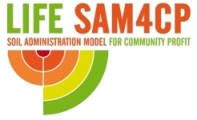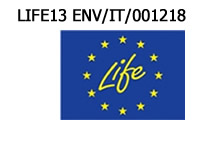This tool simulates the value change of Ecosystem Services
What are ecosystem services?
The land management, aimed at decreasing soil degradation and saving public funds, requires the integration, in decision-making, of an evaluation of ecosystem functions granted by free land.
‘Ecosystem function’ is a technical term used to define the capacity of natural processes and components to provide goods and services that satisfy human needs, either directly or indirectly, and provide life to all species. The Millennium Ecosystem Assessment (2005) has identified potential and varied benefits that humans gain from natural ecosystems in the form of goods and services, defining them with the general term of Ecosystem Services (E.S.).
LIFE SAM4CP project has identified and analysed 7 E.S. that are likely to be more threatened with land consumption:
- Habitat quality: it is a supporting service that checks natural ecosystems’ quality in order to preserve the biological and genetic diversity of the land. The Convention on Biological Diversity (1992) acknowledged the importance and the intrinsic value of biological diversity and of its components. Land consumption is one of the worst threats to biodiversity and eco-biological processes.
Data used to evaluate this E.S. was collected from a survey submitted by national experts who have different skills, varying from environmental management to the biological one.
- Carbon capture and storage: it is a regulating service of the soil. It is essential for the biodiversity, the mitigation and adaptation to climate changes. The soil loss, caused by urban growth and development, is one of the major causes of soil carbon loss.
Information used to calculate this E.S. was issued by Italian National Forest Inventory data and documentation (National Inventory of Forests and forest Carbon pools – INFC) and by other bibliographical researches.
- Crop Pollination: it is an essential regulating and provisioning E.S. for the productivity of numerous crops. The reproduction of most plants and the subsequent production of food for consumption by animals and humans, partly rely on wild pollinator species. Almost 10% of Europe’s native wild bees are currently threatened with extinction. This would result in the subsequent extinction of many species of plants and higher costs in productivity due to artificial pollination. Therefore, this service indirectly benefits the community by keeping the cost of food production low and moderating food costs at the supermarket.
Plant pollination cycles, the activity periods of more than 50 pollinator species in addition to their maximum flight range were used to calculate this E.S. Data was obtained by an accurate bibliographical research based on scientific literature.
- Crop production: it is a provisioning E.S. linked to human use of soil for productivity purposes. Agricultural land covers 40% of the Earth’s surface. The ratio between crop production (or agroforestry land) and ecosystem services is complex. On the one hand crop production is a natural supply service itself, on the other hand agriculture would be impossible without the help of other E.S.
Data used to evaluate this E.S. was taken by the Italian Revenue Angency V.A.M. ( average agricultural land values).
- Timber production: it is a provisioning E.S. directly linked to the quality of the land and the market of goods. The management of the intensity and speed of wood collection is extremely important to preserve the other ecosystem service, such as: habitats, biodiversity, carbon capture and storage, and purification of water.
Due to the lack of punctual and detailed national data, for the evaluation of this E.S., V.A.M. provided by the Italian Revenue Agency were used.
- Mitigation of water erosion of soil: it is a regulating E.S. that consists in the capacity, of soil in good ecosystem conditions, to mitigate the removal of land surface (this part is the richest in organic matter) as a consequence of surface runoff and rainfalls. Although the water erosion phenomenon is a natural process, it might be subjected to a considerable increase due to some human activities. This entails damages: to soil functionality, crop production and, overall, to the environment. The removal of the soil surface, rich in organic matter, reduces considerably its productivity and can lead (in the event that soil is not much deep) to an irreversible loss of cultivable fields.
GIS (Geographic Information System ) data was used for the evaluation of this E.S. on several specific standards provided by the Joint Research Centre, the European Commission’s science and knowledge service.
- Purification of water : it is a regulating E.S. provided by water and terrestrial ecosystems that contribute to filter and rot organic wastes that get to internal waters and to the coast and sea ecosystems, contributing to potable water supply. Natural forests, especially, contribute to a higher quality of waters, with less sediments and contaminants compared to waters coming from basins lacking in forests. There is often a reference to nitrates and phosphates as they are much more widespread elements in domestic and agricultural wastes, particularly, harmful to potable water and the eutrophication of lakes.
The amount of nutrients in agricultural areas was considered for the evaluation of this E.S., by using data from bibliographic researches.
PlaySoil is a tool that evaluates the effects which different types of territory transformation might have on ecosystem services.
It provides an immediate reading of the mapping of the services performed by soil and, even though in a simple way, it lets simulate the change which occurs after the realization of a variation in the land-use.
PlaySoil was conceived following specific standards for the most widespread geographic information tools. It juxtaposes the traditional basic cartographies ( aerial photographs, hybrid map, etc.) and the thematic maps of the 7 most important Italian ecosystem services, which were analysed by LIFE SAM4CP project:
- CS – Carbon
- Cpo – Crop Pollination
- HQ – Habitat quality
- Cpr – Crop production
- TP – Timber production
- NR – Water purification
- SDR – Erosion mitigation
Furthermore, the cartographic representation is enriched by:
- tables and histograms that provide the quantity of the current biophysical value of each E.S., and the simulation of current economical and biophysical values of a surface area of maximum 1,000,000 m2;
- graphic tools which summarize current (biophysical ) and projected (biophysical and economical) values.
N.B: Considering PlaySoil informative and simplified characteristics, the markers referred to either existing or simulated ecosystem values, through a forecast usage transformation, should only be considered as explanatory values. They are the results of some process simplifications and weighted mediations between the analysis of scientific literature and the operative check executed in LIFE SAM4CP research, in 4 case studies. Therefore, the results generated by the simulator cannot be used for institutional purposes.
Simulsoil is an app that analyses value changes as a result of transformations of land use, recording the sensitivity of the environmental services granted to land changes and estimating the overall cost of these transformations on the existing Natural Capital. It allows even inexperienced users to interface with ecosystem analysis and, in a word, to carry out “simulations” that would, otherwise, require a complex data processing and a high technical profile in the use of IT tools and procedures related to GIS.
It is one of the tangible products of the European LIFE SAM4CP project and consists of an analytical territorial support software, aimed primarily at managers and technical personnel belonging to public institutions (Municipalities), for mapping and evaluation of the Ecosystem Services rendered by the soil. Its purpose is to promote and facilitate virtuous urban planning processes, whether they are extended to the entire municipal territory or to portions of it. SimulSoil is in fact born of the need to make the process of knowledge of Ecosystem Services directly scalable to urban planning real practices, ie those necessary to issue qualifications, but also the other procedures that involve transformations of land uses, either through alterations determining its consumption or degradation, or in cases where they generate an environmental and ecosystem improvement.
Considering that soil is a resource that can simultaneously generate multiple Ecosystem Services whose knowledge is essential for the good territorial governance, SimulSoil is, in short, a tool to support the decision making process of public managers for informed and sustainable choices in the exploitation of a substantially finite and non-renewable resource.





